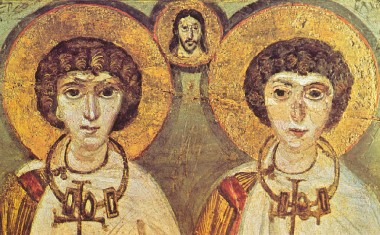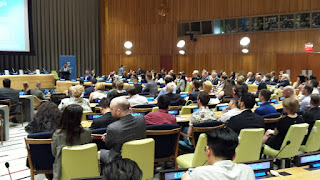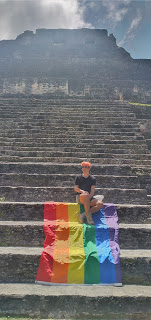When same sex marriage was a rite
WHEN SAME-SEX MARRIAGE WAS A CHRISTIAN RITE1
By ThosPayne
 A Kiev art museum
contains a curious icon from St. Catherine's Monastery on Mt. Sinai in Israel.
It shows two robed Christian saints. Between them is a traditional Roman
‘pronubus’ (a best man), overseeing a wedding. The pronubus is Christ. The
married couple are both men.
A Kiev art museum
contains a curious icon from St. Catherine's Monastery on Mt. Sinai in Israel.
It shows two robed Christian saints. Between them is a traditional Roman
‘pronubus’ (a best man), overseeing a wedding. The pronubus is Christ. The
married couple are both men.
Is the icon suggesting that a gay "wedding" is being
sanctified by Christ himself? The idea seems shocking. But the full answer
comes from other early Christian sources about the two men featured in the
icon, St. Sergius and St. Bacchus,2 two Roman soldiers who were Christian martyrs. These two officers
in the Roman army incurred the anger of Emperor Maximian when they were exposed
as ‘secret Christians’ by refusing to enter a pagan temple. Both were sent to
Syria circa 303 CE where Bacchus is thought to have died while being flogged.
Sergius survived torture but was later beheaded. Legend says that Bacchus
appeared to the dying Sergius as an angel, telling him to be brave because they
would soon be reunited in heaven.
While the pairing of saints, particularly in the early Christian
church, was not unusual, the association of these two men was regarded as
particularly intimate. Severus, the Patriarch of Antioch (512 - 518 CE)
explained that, "we should not separate in speech they [Sergius and
Bacchus] who were joined in life". This is not a case of simple
"adelphopoiia." In the definitive 10th century account of their
lives, St. Sergius is openly celebrated as the "sweet companion and
lover" of St. Bacchus. Sergius and Bacchus's close relationship has led
many modern scholars to believe they were lovers. But the most compelling
evidence for this view is that the oldest text of their martyrology, written in
New Testament Greek describes them as "erastai,” or "lovers". In
other words, they were a male homosexual couple. Their orientation and
relationship was not only acknowledged, but it was fully accepted and
celebrated by the early Christian church, which was far more tolerant than it
is today.
Contrary to myth, Christianity's concept of marriage has not been
set in stone since the days of Christ, but has constantly evolved as a concept
and ritual.
Prof. John Boswell3, the late Chairman of Yale University’s history department,
discovered that in addition to heterosexual marriage ceremonies in ancient
Christian church liturgical documents, there were also ceremonies called the
"Office of Same-Sex Union" (10th and 11th century), and the
"Order for Uniting Two Men" (11th and 12th century).
These church rites had all the symbols of a heterosexual marriage:
the whole community gathered in a church, a blessing of the couple before the
altar was conducted with their right hands joined, holy vows were exchanged, a
priest officiatied in the taking of the Eucharist and a wedding feast for the
guests was celebrated afterwards. These elements all appear in contemporary
illustrations of the holy union of the Byzantine Warrior-Emperor, Basil the
First (867-886 CE) and his companion John.
Such same gender Christian sanctified unions also took place in
Ireland in the late 12th and early 13th centuries, as the chronicler Gerald of
Wales (‘Geraldus Cambrensis’) recorded.
Same-sex unions in pre-modern Europe list in great detail some
same gender ceremonies found in ancient church liturgical documents. One Greek
13th century rite, "Order for Solemn Same-Sex Union", invoked St.
Serge and St. Bacchus, and called on God to "vouchsafe unto these, Thy
servants [N and N], the grace to love one another and to abide without hate and
not be the cause of scandal all the days of their lives, with the help of the
Holy Mother of God, and all Thy saints". The ceremony concludes: "And
they shall kiss the Holy Gospel and each other, and it shall be
concluded".
Another 14th century Serbian Slavonic "Office of the Same Sex
Union", uniting two men or two women, had the couple lay their right hands
on the Gospel while having a crucifix placed in their left hands. After kissing
the Gospel, the couple were then required to kiss each other, after which the
priest, having raised up the Eucharist, would give them both communion.
Records of Christian same sex unions have been discovered in such
diverse archives as those in the Vatican, in St. Petersburg, in Paris, in
Istanbul and in the Sinai, covering a thousand-years from the 8th to the 18th
century.
The Dominican missionary and Prior, Jacques Goar (1601-1653),
includes such ceremonies in a printed collection of Greek Orthodox prayer
books, “Euchologion Sive Rituale Graecorum Complectens Ritus Et Ordines Divinae
Liturgiae” (Paris, 1667).
While homosexuality was technically illegal from late Roman times,
homophobic writings didn’t appear in Western Europe until the late 14th
century. Even then, church-consecrated same sex unions continued to take place.
At St. John Lateran in Rome (traditionally the Pope's parish
church) in 1578, as many as thirteen same-gender couples were joined during a
high Mass and with the cooperation of the Vatican clergy, "taking
communion together, using the same nuptial Scripture, after which they slept
and ate together" according to a contemporary report. Another woman to
woman union is recorded in Dalmatia in the 18th century.
Prof. Boswell's academic study is so well researched and
documented that it poses fundamental questions for both modern church leaders
and heterosexual Christians about their own modern attitudes towards
homosexuality.
For the Church to ignore the evidence in its own archives would be
cowardly and deceptive. The evidence convincingly shows that what the modern
church claims has always been its unchanging attitude towards homosexuality is,
in fact, nothing of the sort.
It proves that for the last two millennia, in parish churches and
cathedrals throughout Christendom, from Ireland to Istanbul and even in the
heart of Rome itself, homosexual relationships were accepted as valid
expressions of a [Christian] god-given love and commitment to another person, a
love that could be celebrated, honored and blessed, through the Eucharist in
the name of, and in the presence of, Jesus Christ.
"... in the
evening the youth came to him [Jesus], wearing a linen cloth over his naked
body. And he remained with him that night, for Jesus taught him the mystery of
the Kingdom of God. And thence, arising, he returned to the other side of the
Jordan." —The Secret Gospel of Mark, The Other Bible, Willis Barnstone, Editor, Harper & Row, San Francisco, 1984,
pp. 339-342.
Source:
1. ColfaxRecord.com;
Retrieved 6 Jul 2009, 1830 PST [ http://www.colfaxrecord.com/detail/91429.html
]
2. Saints Sergius & Bacchus, Roman martyrs. Their
Catholic feast day is October 7th. Catholic Encyclopedia [http://www.newadvent.org/cathen/13728a.htm
]
Source: http://www.christianity-revealed.com/cr/files/whensamesexmarriagewasachristianrite.html



Comments
Post a Comment